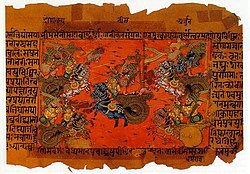Indian calligraphy
Historical evolution of Indian Calligraphy
Early calligraphy

On the subject of Indian calligraphy, Anderson 2008 writes:
Aśoka's edicts (c. 265–238 BC) were committed to stone. These inscriptions are stiff and angular in form. Following the Aśoka style of Indic writing, two new calligraphic types appear: Kharoṣṭī and Brāhmī. Kharoṣṭī was used in the northwestern regions of India from the 3rd century BC to the 4th century of the Christian Era, and it was used in Central Asia until the 8th century.
Copper was a favoured material for Indic inscriptions. In the north of India, birch bark was used as a writing surface as early as the 2nd century AD. Many Indic manuscripts were written on palm leaves, even after the Indian languages were put on paper in the 13th century. Both sides of the leaves were used for writing. Long rectangular strips were gathered on top of one another, holes were drilled through all the leaves, and the book was held together by string. Books of this manufacture were common to Southeast Asia. The palm leaf was an excellent surface for penwriting, making possible the delicate lettering used in many of the scripts of southern Asia.
Middle ages
Indian traders, colonists, military adventurers, Buddhist monks and missionaries brought the Indic script to the countries of South East Asia.

The languages of these regions were influenced by the Indic script; the influence came in the form of the basic internal structure, the arrangement and construction of syllabic units, manner of representation of characters, and the direction of writing (left to right) (Gaur 2000: 98). Fine Sanskrit calligraphy, written on palm leaf manuscripts was transported to various parts of South East Asia, including Bali (Ver Berkmoes ?: 45).

It is hypothesized that Persian influence in Indian calligraphy gave rise to a unique and influential blend in Indian calligraphy, although it should be noted that a number of different calligraphic traditions existed in India and that Indian scripts were fundamentally different from scripts used in Arabic and Persian traditions. Some of the notable achievements of the Mughals were their fine manuscripts; usually autobiographies and chronicles of the noble class, these manuscripts were initially written in flowing Persian language. This style of calligraphy was thought to influence other traditions of India, such as the Indian epics, including the Ramayana and Mahabharata (Bose & Jalal 2003: 36).

Emperor Humayun had bought Persian calligraphers into India; they would later be joined by native Hindu artists of India to further promote this art in the court of emperor Akbar (Bose & Jalal 2003:36).
The Arabic text on the Qutab Minar is in the Kufic style of calligraphy; decorations with flowers, wreaths and baskets show the native influence of Hindu and Jaina traditions (Luthra ?: 63).
Sikhism played a key role in the history of Indian calligraphy. The holy book of the Sikhs has been traditionally handwritten with illuminated examples. Sikh calligrapher Pratap Singh Giani is known for one of the first definitive translations of Sikh scriptures into English.
The Oxford manuscript of Shikshapatri is an excellent example of Sanskrit calligraphy. The manuscript is preserved in the Bodleian Library (Williams 2004: 61).
Features of Indian Calligraphy
Religious texts are the most frequent subject for calligraphy. Monastic Buddhist communities had members trained in calligraphy having shared responsibility for duplicating sacred scriptures (Renard 1999: 23-4). Jaina traders incorporated illustrated manuscripts celebrating Jaina saints. These manuscripts were produced using inexpensive material with fine calligraphy (Mitter 2001: 100).
See also
Sources
- Salomon, Richard. Indian Epigraphy : A guide to the study of inscriptions in Sanskrit, Prakrit, and other Indo-aryan languages. New York, Oxford University Press : 1999.
- Stevens, John . Sacred Calligraphy of the East. Boston, Shambala : 1995.
- Anderson, D. M. (2008), Indic calligraphy, Encyclopedia Britannica 2008.
External links
- Devanagari script on Omniglot. This site also has information on a range of Indian scripts.
- Sanskrit mantra calligraphy in the Siddham script
- Scripts and Languages of India
